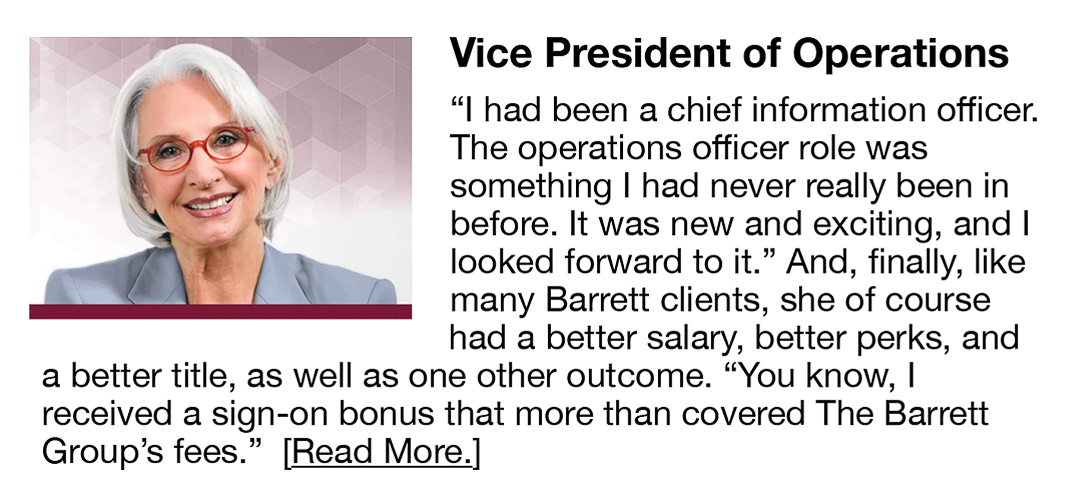
INDUSTRY UPDATE: Female Executives
Introduction
In 2024 10.4% of the companies in the Fortune 500 sported female CEOs. They number 52 in all, equal to 2023 but also a historic high, having doubled since 2018. In the table below are the highest ranking [see source].
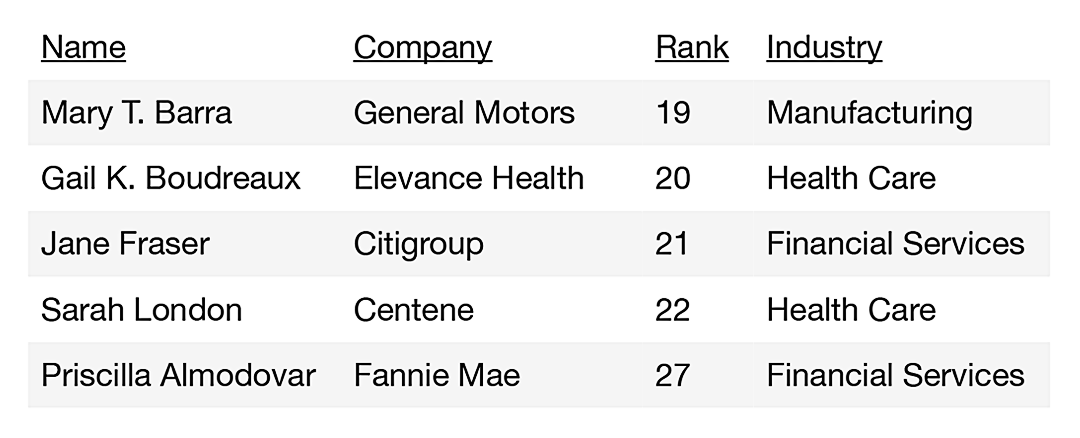
In its tenth annual survey of women in the workplace, McKinsey summarized three key points about progress so far:
- First, companies took action that has led to important progress.
- Second, change is hard and messy. And we’re somewhere in the middle of the shifts needed to fix the pipeline and make the culture of work more equitable.
- Third, the gains made are more fragile and less extensive than they appear. [See source.]
The same study suggests that women comprise 29% of C-Suite positions. That is up from 17% in 2015 and the same percentage holds true at the Senior Vice President level. Slightly more (34%) of Vice Presidents are female per the survey. Whereas, Directors and Senior Managers come in at about 37%, and Managers at 39%. For context, entry level employees tend to be about 48% female.
Two other key findings include the fact that women of color face even worse prospects than their white counterparts. And the persistence of what McKinsey calls the “broken rung” on the corporate ladder (the fact that far more men become managers than women) continues to hold women’s promotions back. At the current rate according to the study it will take 22 years for white women to achieve gender parity with men. And it will take 48 years for women of color to do the same. [See source.]
A Hollow Gain
Forbes goes on to examine the actual roles women have been gaining. It says, essentially, that much of the recent growth in corporate headcount has been in staff roles. These are roles that support a company’s employees (such as HR or legal counsel) as opposed to line management roles with profit-and-loss responsibility which are still predominantly occupied by men. In conclusion, “the gains we see are less attributed to the promotion of more women into the VP, SVP, and C-suite and more a consequence of adding or removing specific roles at these senior levels.” [See source.]
| “Research shows that firms with more women in senior positions are more profitable, more socially responsible, and provide safer, higher-quality customer experiences.” |
Beyond the obvious fact that women comprise about half the population but only a tenth of the top management tier and 29% of all executives in top leadership teams, why is gender parity important? The Harvard Law School’s research concludes:
The world needs more women leaders. Research shows that firms with more women in senior positions are more profitable, more socially responsible, and provide safer, higher-quality customer experiences. [See source.]
Beyond gender, what about economic parity? How do women stack up on this parameter?
Gender Pay Gap
Morning Star (a fund rating firm) has access to huge volumes of corporate data and recently came up with some intriguing insights on compensation. Surprisingly, in a head-to-head comparison, women CEOs actually out-earned their male counterparts according to this source at least in a representative annual data set.
Across titles typically held by the highest paid executives at S&P 500 companies, there appears to be no systematic difference in the average earnings of men and women in those roles. At the very top, women CEOs outearned their male counterparts across the S&P 500 in 2022—by an average of $2 million! And women CFOs were paid $1 million more, on average. [See source.]
Nevertheless, women executives do in fact earn less than men. “According to last year’s corporate pay disclosures, women holding the senior-most executive roles in the largest companies in the US earned around 85 cents for every dollar earned by men in these roles. This ratio has ranged between 75% and 88% over the past 10 years.” [See source.]
Two prominent reasons are evident. First, women tend to predominate in lower paying roles, such as the human resources and legal counsel staff positions noted above. Second, women are radically underrepresented in the highest paying roles, i.e., CEO, COO, etc. Beyond this, according to the same source, the larger the company, the less likely women are to inhabit the most lucrative positions.
…women become progressively scarcer in companies with higher market capitalizations. While their representation in senior management increases slightly with company size, women’s participation in senior management and C-suite roles, as a percentage of total positions, remains far below their participation in the general workforce, even at the largest, most visible companies. [See source.]
The Advantages of Gender-Balanced Leadership…
Underlining this observation, Harvard Law School research finds only “six S&P 100 leadership teams are comprised of 50% or more women, meaning the vast majority (91) have yet to reach gender parity.” [See source.]
This may in fact be a structural disadvantage for those companies with lopsidedly male leadership according to another research finding because “ultimately, women are more effective at building rapport among mixed-gender teams than men, and doing so often leads to higher productivity and stronger sales…” The research goes on to conclude: “Our findings underscore that, even if we bring women in on the front lines, we may not be setting them up for success if we don’t also improve female representation at the management level in parallel. Not only should we rebalance gender parity at managerial levels, but right now we’re skewed the wrong way in almost every industry and every part of the world.” [See source.]
| “We may not be setting [women] up for success if we don’t also improve female representation at the management level.” |
Still, there are many obstacles to achieving this “ideal” state. McKinsey’s study highlights the role of micro-aggressions in the workplace, of a higher incidence of age-bias for women than men, and the well-documented effects of parenting that inequitably hobble women’s careers more than men’s. The firm also offers an extensive checklist of measures that companies can take to improve the work environment for women. [See source.]
…and the Obstacles
Diversity, Equity, and Inclusion (DEI) initiatives figure prominently in this list of measures, but as anyone who hears or reads the news must know, political winds in the US and elsewhere are blowing stiffly against such measures. Companies are quietly or more openly scaling back their public commitment to DEI. Forbes’ “here are all the companies scaling back DEI initiatives” article provides potentially depressing reading for women executives. However, in some cases, specific communities are also fighting back, such as the 40-day boycott of Target recently announced by one church in the US. [See source.] We will all see how this political debate will unfold, but, frankly, it may be more about public gestures than substance.
There are pockets of particularly high female executive participation, notably in the Nordic countries of Europe as observed by The Economist in an interesting video [see source] on the overall subject of women in the workplace that concludes on a few basic recipes for addressing gender inequity:
- The motherhood penalty—80% of women employees never return from parental leave; this automatically thins the ranks of women available for advancement unless there are strong child care, parental leave and flexible leave policies in place to offset this biological inequity (as there are in the Nordic countries).
- Male culture—so much of corporate culture is subtly biased toward male norms of behavior; for example, working long hours is good, or, prioritizing the company over your personal life is a positive.
- Reset practices to gender neutrality and parity for all comers—particularly at the hiring stage.
Measures for De-Biasing…
De-biasing peoples’ ways of thinking is inevitably difficult and it takes time. To this end, Forbes interviewed a number of successful women executives to collect their thoughts on what needs to change.
| There are pockets of particularly high female executive participation, notably in the Nordic countries of Europe. |
Here are some of their key thoughts [see source]:
“We need to completely shatter the idea that full-time work has to be 40+ hours. A 30-hour workweek would make it possible for more women to go into leadership.”
“We need to challenge the cultural norm that fathers are not caregivers […] Longer paid paternity leave would be transformational in fostering workplace equality.“
“Are we creating equitable access to sponsorship, mentorship, and coaching needed for advancement?”
“So locking arms with men and saying, ‘Hey, you’re part of the solution here’ is critical. […] We need to create environments of gender partnership and inclusion that help everyone thrive and advance equally.”
“Performance outcomes shouldn’t be measured by how much money you make, but by how much positive impact, happiness, and well-being you contribute to society[…]“
…and How to Fix Ingrained Inequities
And here are their key conclusions on how to fix the ingrained inequities [see source]:
- Revise job structures to accommodate flexible work schedules and ensure leadership expectations do not require unsustainable hours.
- Normalize paternity leave and caregiving responsibilities for men to balance gender roles in the workplace and at home.
- Track and report leadership diversity metrics—not just overall representation, but pay equity, retention, and promotion rates.
- Encourage sponsorship, not just mentorship, with senior leaders actively advocating for high-potential women.
- Educate boards and hiring committees on unconscious bias in leadership selection.
- Tie executive compensation to diversity and inclusion progress, ensuring gender equity remains a business priority.
- Reframe gender equity as a business advantage, emphasizing its impact on financial performance and company success.
- Access Resources and Tools. For example, Catalyst has a wealth of resources for how to navigate the changing landscape of leadership.
Well, clearly there is much work to be done to help female executives to achieve their full potential. In the meantime, let us see in more detail where these industrious women currently work and what they do as they tread the path toward parity with men.
The Market for Executives
Applying our criteria (see Editor’s Note), there are almost 3.4 million female executives in our sample (28% of the total executive population), slightly more than 2 million in the US and Canada (31%), 1.3 million in the UK and EU (26%), and 116,000 (18%) in the Middle East. Combined, male and female executive head count grew by about 0.7% in the past year, while almost 500,000 changed jobs, bringing the total executive opportunity to about 580,000 positions—presumably, 162,000 of them for female execs.
Executive Titles
Chart 1 examines the titles held by female executives. The top title, Director, is held 34% of the time by women. “Demand” in this context represents only the help-wanted ads published on LinkedIn (a maximum of 25% of the actual demand according to The Barrett Group’s experience because 75% of our clients land via the Unpublished Market.) The Director title also demonstrated the highest (all-gender) demand.

While seemingly impressive, the CEO title at rank two and more than 650,000 individual female execs also exemplifies the relatively low share (just 26%) women hold of the most lucrative roles—as we addressed in the introduction. Share-wise, Executive Director (51% female), CMO (43%), General Counsel (39%), Co-President (43%) and CHRO (66%) also stand out, though the demand for these roles seems to be quite low.
Industries Employing Female Executives
There are, however, marked differences between industries as far as the share of female executives is concerned as explained in Chart 2. Non-profits (50%) not only rank at number 1, but exhibit very strong (+12.7%, all-gender) growth year on year. Other sectors with high female exec shares include Education Administration (51%), Individual and Family Services (50%), Civic and Social Organizations (45%), Wellness and Fitness Services (45%), Medical Practices (44%), Hospitals and Health Care (43%), and Higher Education (42%).
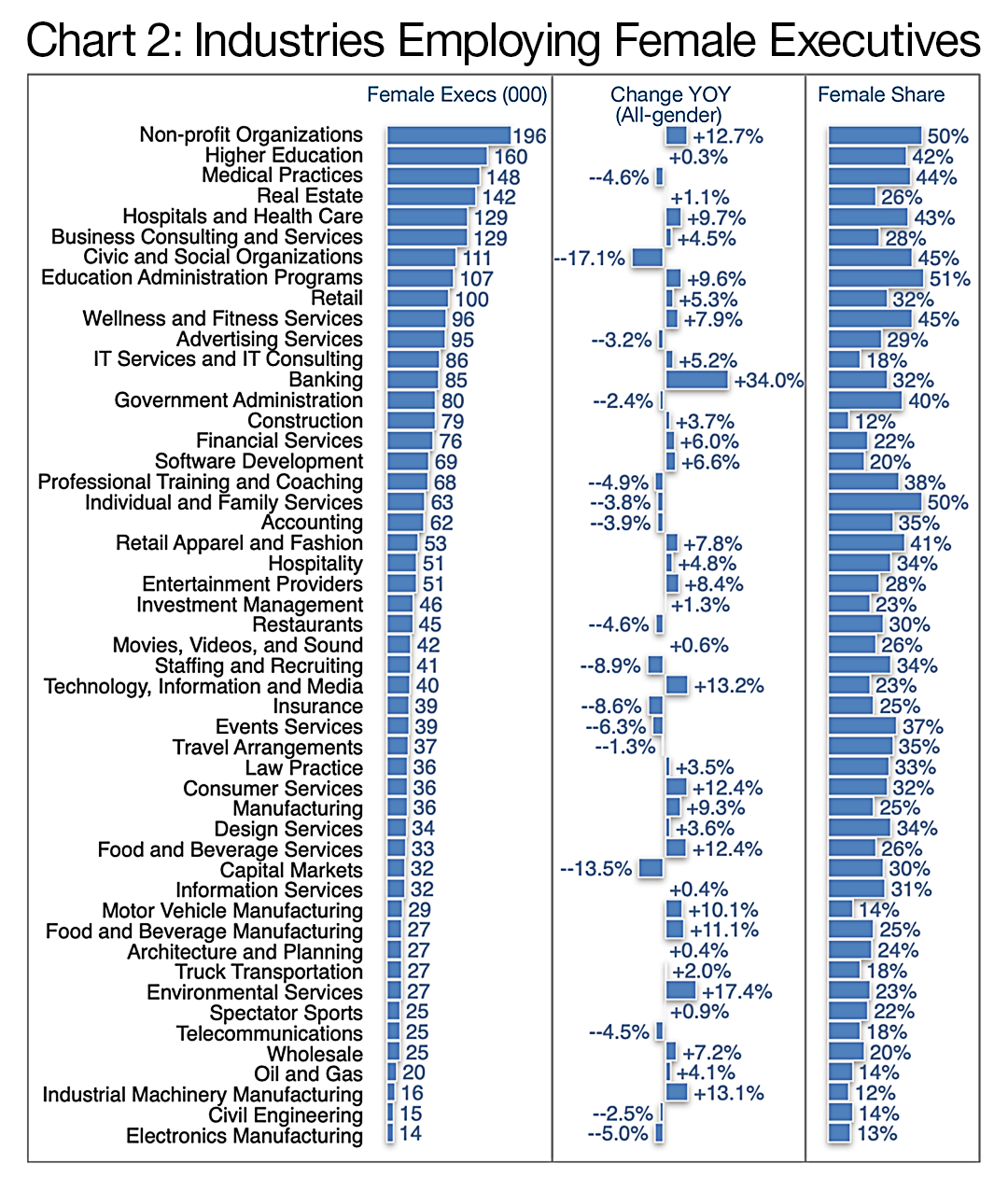
Clearly, not all of these show strong growth. Some of them are even shrinking palpably, which is why The Barrett Group (TBG) helps clients really tailor their career change programs to specific companies in targeted sectors with strong growth opportunities. Banking stands out as one sector that grew strongly in the past year, though the growth spurt may not continue. [Read more in our Financial Services Industry Update.]
Female Executives’ Specializations
When we look into the specializations that female executives have included in their LinkedIn profiles in Chart 3, we see again areas where women seem to be far more prevalent and others where they remain scarce. As far as the female share is concerned, again, Nonprofit Organizations (52%) lead the pack, followed by Nonprofit Board Development (51%), Fundraising (50%), Human Resources (47%), Organizational Development (43%), Health Care and Leadership Development (42%), Social Networking and Recruiting (41%), and Marketing Communications (40%).
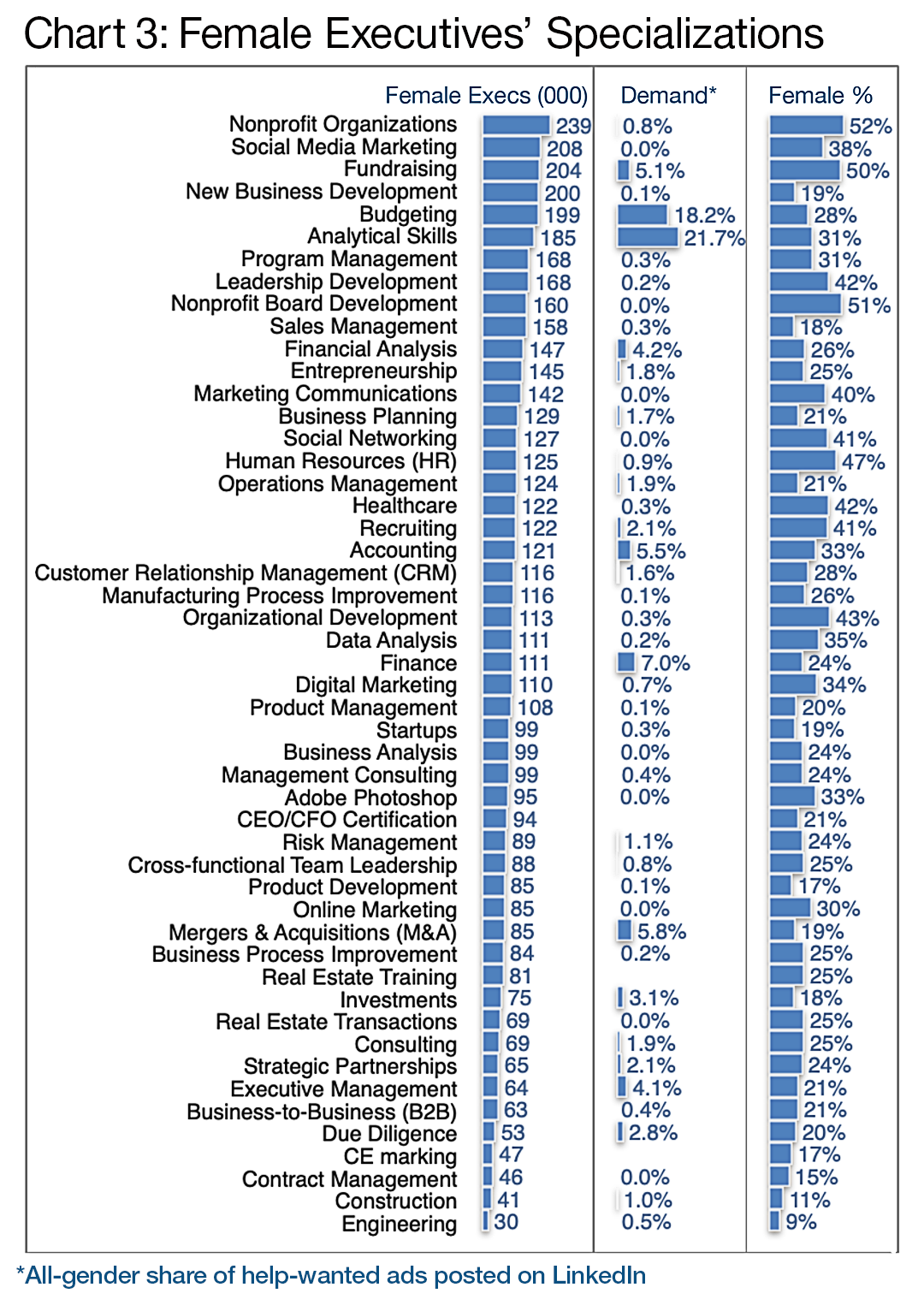
Among the specializations that directly generate revenue, for example, New Business Development (19% female) or Sales Management (18%), and therefore often attract the highest remuneration (see the Introduction), women do not come off as well. The demand data in Chart 3 again refers only to the published market so it significantly understates the actual demand, however, it does indicate which of the positions were advertised most frequently by employers. In a trend that we see across industries, Analytical Skills comes out at the top (21.7% on an all-gender basis) followed by other related specializations such as Budgeting (18.2%), Finance (7%), M&A (5.8%), and Accounting (5.5%).
LinkedIn does not publish gender data for companies, however, as addressed in the Introduction, In 2024 the Fortune 500 included 52 female CEOs, equal to 2023 but also a historic high, having doubled since 2018. Here again are the highest ranking [see source.]
Female Executives’ Locations
Chart 4 shares the employment locations of female executives whereby, the most important data point may be the all-gender, future-oriented hiring demand. TBG helps clients map their career plans to meet their title, role, compensation, and location goals and we encourage all executive candidates to plan assiduously for success.
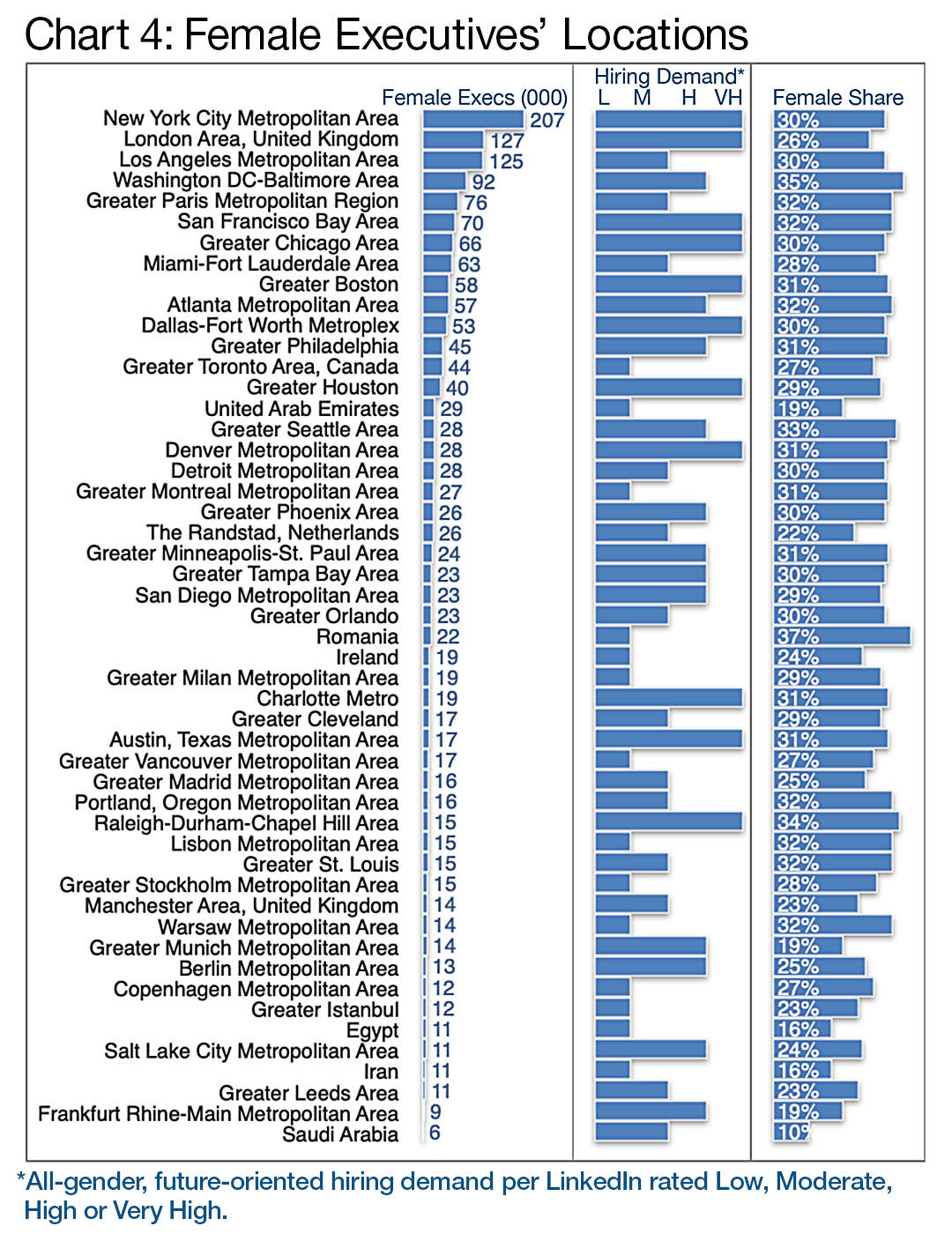
Selected TBG Client Success Studies
Editor’s Note:In this Update “executives” will generally refer to the Vice President, Senior Vice President, Chief Operating Officer, Chief Financial Officer, Managing Director, Chief Executive Officer, Chief Marketing Officer, Chief Information Officer, Managing Partner, General Counsel, Head, President and Director titles principally located in the US, Canada, Europe, the UK, and/or the Middle East. Unless otherwise noted, the data in this Update will largely come from LinkedIn and represents a snapshot of the market as it was at the time of the research. Is LinkedIn truly representative? Here’s a little data: LinkedIn has more than 1 billion users. (See source.) It is by far the largest and most robust business database in the world, now in its 20th year. LinkedIn Talent Insights data is derived by aggregating profile data voluntarily submitted by LinkedIn members. As such, LinkedIn cannot guarantee the accuracy of LinkedIn Talent Insights data. |
Peter Irish, Chairman
The Barrett Group
Click here for a printable version of INDUSTRY UPDATE: Female Executives
TBG’s Most Recent Industry Updates


